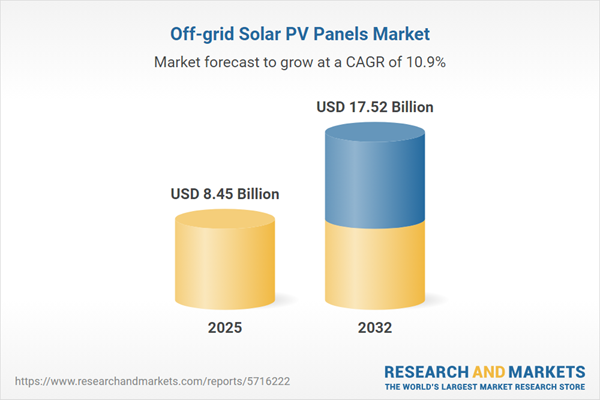Speak directly to the analyst to clarify any post sales queries you may have.
Off-grid solar PV panels are becoming an essential energy solution for senior decision-makers addressing the challenges of remote operations, sustainability compliance, and supply resilience where grid connectivity is inadequate. These systems foster operational stability and sustainability, helping organizations navigate evolving business landscapes reliably.
Market Snapshot: Global Off-Grid Solar PV Panels Market Overview
The global off-grid solar photovoltaic (PV) panels market reached USD 7.63 billion in 2024, with expectations to rise to USD 8.45 billion by 2025 and further to USD 17.52 billion by 2032, driven by a compound annual growth rate of 10.94 percent. This expansion is sustained by technological advances in PV efficiency, greater manufacturing scalability, and increasing demand for reliable energy in underserved areas worldwide. Senior decision-makers are turning to off-grid solar PV panels to reinforce operational dependability, meet new regulatory expectations, and proactively manage sustainability responsibilities in response to heightened energy challenges.
Scope & Segmentation of the Off-Grid Solar PV Panels Market
- Module Types: Monocrystalline panels cater to settings requiring maximum efficiency and minimal spatial footprint, while polycrystalline modules offer a balanced solution for broad commercial and industrial deployment. Thin film panels address unique needs for flexible or portable energy systems, enhancing adaptability across varied application sites.
- Component Selection: Flow batteries support organizations requiring long-duration storage and consistent energy supply. Lead acid batteries are preferred for cost-focused backup needs. Lithium-ion batteries address requirements for compact, high-density storage. Inverters—including hybrid, string, and microinverters—enable seamless system integration and scale adaptation. Charge controllers such as MPPT and PWM types improve energy storage efficiency. Pre-assembled kits facilitate faster on-site deployments.
- Applications: Off-grid solar PV panels are implemented across commercial, industrial, and residential sectors. They are particularly valuable in mission-critical environments like mining and heavy industry, where continuous operations and uninterrupted energy access are priorities, even in isolated regions.
- Geographical Coverage: Adoption spans the Americas, Europe, the Middle East, Africa, and Asia-Pacific, with system designs shaped by each region’s regulatory requirements, environmental conditions, and infrastructure landscapes. Regional disparities influence both deployment strategies and technical specifications.
- Key Companies Analyzed: Major industry players shaping the technology landscape include JinkoSolar Holding Co., Ltd., LONGi Green Energy Technology Co., Ltd., JA Solar Technology Co., Ltd., Trina Solar Co., Ltd., Canadian Solar Inc., Hanwha Q CELLS Co., Ltd., GCL System Integration Technology Co., Ltd., Risen Energy Co., Ltd., First Solar, Inc., and SunPower Corporation.
Key Takeaways for Senior Decision-Makers
- Off-grid solar PV panels lower operational risks stemming from infrastructure disruptions, supporting risk management for remote and cross-border initiatives.
- Modular infrastructure design provides scalability, enabling organizations to expand or adapt systems incrementally as evolving business needs demand with little workflow disruption.
- Simplified compliance processes and adaptive regulatory environments facilitate smoother project development for established firms and new entrants seeking off-grid solutions.
- Modern storage and microgrid management technologies allow enterprises to respond effectively to variable energy requirements or external influences such as weather and demand changes.
- Strategic partnerships with technology suppliers and system integrators accelerate deployment, enhance system reliability, and support rapid project execution.
Tariff Impact: Navigating Market Disruption
Recent changes to United States tariff regulations are influencing the sourcing strategies and supply chain management of off-grid solar PV solutions. Manufacturers are expanding domestic capacities and pursuing diverse supplier relationships to maintain reliable supply. Organizations are encouraged to prioritize flexible system designs and reassess partnerships to remain agile in response to evolving policy landscapes.
Methodology & Data Sources
This analysis reflects insights collected through expert interviews, direct industry stakeholder engagement, and detailed review of major databases and academic resources. The approach aligns with prevailing regulatory benchmarks, equipping senior leaders with a solid foundation for investment and strategic planning.
Why This Report Matters
- Equips organizations with strategies to enhance operational stability and streamline supply chains, supporting success in off-grid or challenging environments.
- Provides intelligence on technological evolution and regulatory change, enabling informed decision-making for executive leaders.
- Supports risk management initiatives and helps identify opportunities related to broader adoption of off-grid solar PV solutions across various industries.
Conclusion
Off-grid solar PV panels empower organizations with reliable energy access, advance sustainability targets, and strengthen business resilience amid changing operating conditions.
Additional Product Information:
- Purchase of this report includes 1 year online access with quarterly updates.
- This report can be updated on request. Please contact our Customer Experience team using the Ask a Question widget on our website.
Table of Contents
3. Executive Summary
4. Market Overview
7. Cumulative Impact of Artificial Intelligence 2025
Companies Mentioned
The companies profiled in this Off-grid Solar PV Panels market report include:- JinkoSolar Holding Co., Ltd.
- LONGi Green Energy Technology Co., Ltd.
- JA Solar Technology Co., Ltd.
- Trina Solar Co., Ltd.
- Canadian Solar Inc.
- Hanwha Q CELLS Co., Ltd.
- GCL System Integration Technology Co., Ltd.
- Risen Energy Co., Ltd.
- First Solar, Inc.
- SunPower Corporation
Table Information
| Report Attribute | Details |
|---|---|
| No. of Pages | 194 |
| Published | October 2025 |
| Forecast Period | 2025 - 2032 |
| Estimated Market Value ( USD | $ 8.45 Billion |
| Forecasted Market Value ( USD | $ 17.52 Billion |
| Compound Annual Growth Rate | 10.9% |
| Regions Covered | Global |
| No. of Companies Mentioned | 11 |









